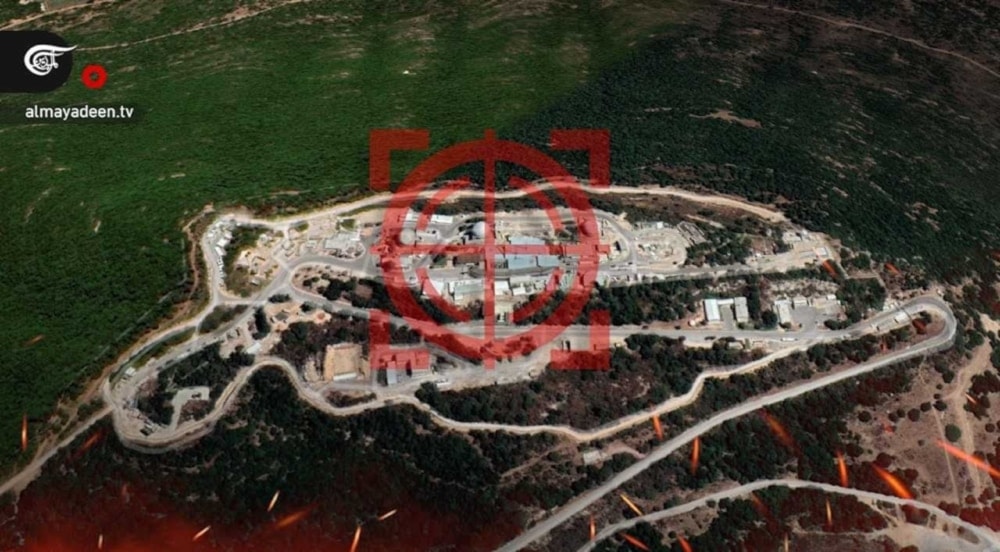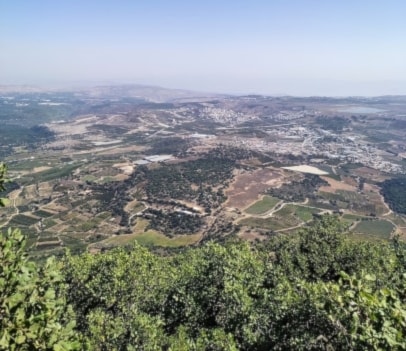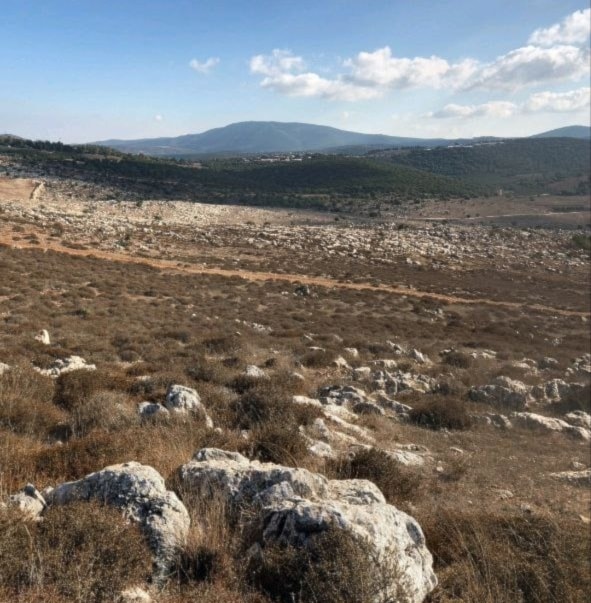Why did Hezbollah strike the Israeli 'Meron' intel, airforce base?
This is the first time during this battle that Hezbollah strikes Mount "Meron" and its military base serving as the primary security and military command center for aerial warfare and intelligence on the northern front.
-

An aerial image of the Israeli army air control and surveillance "Meron" base, revealing advanced radar systems, communication systems, and monitoring equipment.
In a significant development, the Islamic Resistance in Lebanon Hezbollah announced on Saturday morning that it had targeted the Israeli army air control and surveillance "Meron" Base, situated atop Mount Jarmaq.
This attack marked the first time that the base, a strategic center for the entire Israeli entity, and a primary intelligence and military command hub on the northern front, had been targeted during the ongoing border escalations between the Resistance and the occupation army.
"Meron" Base: A hub for Israeli electronic warfare in the region
Located just 8 kilometers from Lebanon's southern border, "Meron" Base overlooks the Lebanese towns of Rmeish, Yaroun, and Maroun al-Ras in the central sector. It occupies the summit of Mount Jarmaq in northern occupied Palestine, making it the highest peak within the occupied territories.
Sitting at an altitude of approximately 1200 meters above sea level, the base sprawls across an area of up to 150,000 square meters, with a substantial portion of the surrounding areas believed to be under its control for military and intelligence purposes.
According to the Resistance statement released today, "Meron" primarily serves as an aerial surveillance center.
It is the sole facility responsible for managing and controlling air operations toward Syria, Lebanon, Turkey, and Cyprus, as well as the northern part of the eastern Mediterranean Sea basin. Moreover, this base acts as a central hub for electronic warfare interference in the mentioned directions, staffed by a significant number of elite Israeli officers and soldiers.
Read more: Hezbollah's 'Meron' attack 'trailer' of what is to come: Israeli media
-

mountain's top as seen from Lebanon
-

Mount "Meron"/Jarmaq from the Lebanese town of Yaroun
A report by a specialized research group based in the US state of Texas, which was brought to light by Israeli media months ago, revealed problems in pinpointing the locations of some civilian aircraft in the region, particularly over southern Lebanon and northern occupied Palestine.
After precise monitoring of jamming signals disrupting receivers' ability to detect satellite waves, "Mount Meron" was determined as the source of interference against civilian GPS devices.
Indeed, satellite-based location systems were entirely disrupted during the first week following the Al-Aqsa Flood operation. Israeli media reported that the disruption was aimed at preventing the Resistance in Lebanon from using devices for precise missile or drone strikes against the entity.
The targeting of "Meron" by Hezbollah holds strategic significance of disrupting, or even with later operations potentially hindering, "Israel's" ability to conduct precise military strikes.
#متداول:
— الميادين لبنان (@mayadeenlebanon) January 6, 2024
لحظة استهداف قاعدة "ميرون" للمراقبة الجوية الإسرائيلية من قبل #المقاومة_الإٍسلامية في لبنان.#لبنان#الميادين_لبنان pic.twitter.com/pZr8dnixie
A center for aerial operations against Lebanon and Syria
Historically, the high-base served as the command center for Israeli aerial operations and surveillance on the northern front of the occupation.
Its geographical position offers direct surveillance of a substantial portion of Lebanese territory and complete oversight, including broadcasting and receiving capabilities. This provides the base with powerful control and communication abilities towards Lebanon. Moreover, for hostile operations against Syria, "Meron" Base is complemented by radar and broadcasting facilities located on the occupied Mount Hermon, overlooking Syrian territories.
In recent years, the base has gained increased significance, especially with the expanded use of military drones.
As "Israel" increasingly relies on UAVs for intelligence gathering in Lebanon and Syria on a nearly daily basis, the base has emerged as the primary command center for aerial operations against both countries. It facilitates direct communication with the drones, ensuring uninterrupted connectivity and making it more challenging to disrupt their signals. The base also streamlines military operations due to the concentration of communication devices, command centers, and radars on "Mount Meron."
Read more: Lebanon files complaint with UN over Israeli aggressions
Advanced Intelligence gathering capabilities
Thanks to its extensive geographical oversight of Lebanese territory, the base can receive and broadcast various wireless communications directly to and from Lebanon. This makes it a critical communication component with informants and a central hub for tracking and monitoring wireless communications, including espionage activities.
The base's giant advanced cameras and modern monitoring devices provide strategic oversight over a large portion of the line between Lebanon and occupied Palestine. It also covers Israeli sites and their corresponding locations in Lebanon.
Consequently, "Meron" Base plays a pivotal role in intelligence gathering that was previously concentrated in locations in proximity with the Lebanese borders, many of which have been targeted and destroyed by the Resistance in recent weeks.
Read more: Unsure 'Israel' will be able to fight Hezbollah: Ex-Mossad officials
Meron as a strategic target
The strategic base has not been immune to threats since the beginning of the military escalation in southern Lebanon.
Many Israeli analysts have spoken about the possible evolution of the Resistance's targets list. This is particularly relevant given that Hezbollah previously repeatedly struck the base during the 2006 July war, which resulted in the death of two settlers and the injury of five others, as acknowledged by Israelis.
However, attacking the base today during a period below the threshold of an all-out war constitutes a heavy blow to the entity. Its implications go beyond direct consequences.
The Resistance has meticulously chosen the nature of its targets throughout this period as part of its precise management of the escalation ladder with the Israelis.
Over the past three months, Hezbollah has effectively controlled the pace and general course of events, compelling the Israelis to adhere to its equations.
Read more: Israeli settlers fear new kind of war with Hezbollah: Washington Post
This applies to the military operations zone, the nature of the strikes within Lebanon, and the deterrence of the occupation from targeting Lebanese civilians within the equation of reciprocity.
However, "Israel's" assassination of Palestinian Resistance leader Sheikh Saleh Al-Arouri and a number of his comrades in Beirut's southern suburb (Dahyeh) with missile strikes, prompted Hezbollah to opt for an escalation.
Today's strike was described by Hezbollah as an "Initial Response" to the assassination of al-Arouri, leaving the door open for potential confrontations should the occupation entity decide to respond to this escalation in kind.
Historical and religious significance
In addition to the military and intelligence critical role it provides to the Israeli entity, the "Meron" Base holds special importance for Zionist Jews, as they consider the mountain itself to be mentioned in the Torah and revere a tomb they claim belongs to a Jewish Rabbi who lived in the second century AD.
Annually, Zionist Jews hold celebrations near his alleged tomb located in the settlement of "Meron" on the eastern slope of the mountain, overlooking the Lebanese side, situated about one and a half kilometers from the mountain's peak and the base.
Within this settlement, which has a population of approximately 1,500 inhabitants at best, there are several graves and shrines that Zionist Jews claim belong to revered figures. They insist on celebrating there annually because the area holds particular sanctity for Eastern Sephardic Jews.
The settlement was established after the Nakba in 1949 on the ruins of the Palestinian town of Meron. Meanwhile, occupation settlers looted its artifacts and a history dating back about 2,000 years.
It was within this settlement that the largest non-military catastrophe in the history of the occupation occurred in 2021 when grandstands collapsed during religious commemorations attended by settlers. The stampede resulted in the deaths of approximately 50 settlers.
Read more: Israeli military achieved no goals in Gaza, Hamas in control
-

The Zionists' "sacred shrine" for Rabbi Shimon Bar Yochai in "Meron".
A severe response
#متداول:
— الميادين لبنان (@mayadeenlebanon) January 6, 2024
لحظة استهداف قاعدة "ميرون" للمراقبة الجوية الإسرائيلية من قبل #المقاومة_الإٍسلامية في لبنان.#لبنان#الميادين_لبنان pic.twitter.com/pZr8dnixie
Striking the "Meron" Base with precision-guided missiles marks Hezbollah's confirmation that it has introduced the latest-generation Kornet E-M missiles into the battle.
These missiles have a range of up to 10 kilometers and were most likely used in the accurate targeting of the base, as indicated by footage recorded by one of the Zionist settlers during the strike today.
-

A Kornet E-M system in an arms exhibition ( © RIA Novosti / Alexander Melnikov)
The precision targeting of a base of such importance, housing command centers and equipment worth hundreds of millions of dollars and regularly hosting leaders of the occupation's military, in addition to specialized and elite personnel, is indicative of the base now serving as a prime target for the Resistance. It also signifies that the Israeli entity is facing a genuine predicament.
While its main headquarters in the north is now under imminent threat from Hezbollah, the occupation entity cannot evacuate the base, pushing "Israel" into a very difficult dilemma. Additionally, the Resistance has effectively pushed the front line with the Israeli entity to 8 kilometers inside the occupied Palestinian borders.
Furthermore, Israeli generals had believed that their main headquarters were largely out of the Resistance's reach and that their war against it was mostly remote, relying on aircraft and drones. This has changed after the operation today.
Most importantly, given the base's role in operating and coordinating air strikes, the base is a central target to respond to the occupation army for assassinating al-Arouri earlier this week.
Therefore, it can be concluded that the "calamity of the occupation is great" today, as the military leadership's headquarters in the north has been targeted. This means that the Resistance has placed the ball in the court of the Israeli army and its government.
Israelis must choose between remaining silent in the face of this humiliating and perilous strike, or heading toward a response, the repercussions and limits of which they do not know.
Read more: UK intel officer/CNN staffer suspected for spying on Hezbollah in Leb.

 9 Min Read
9 Min Read








